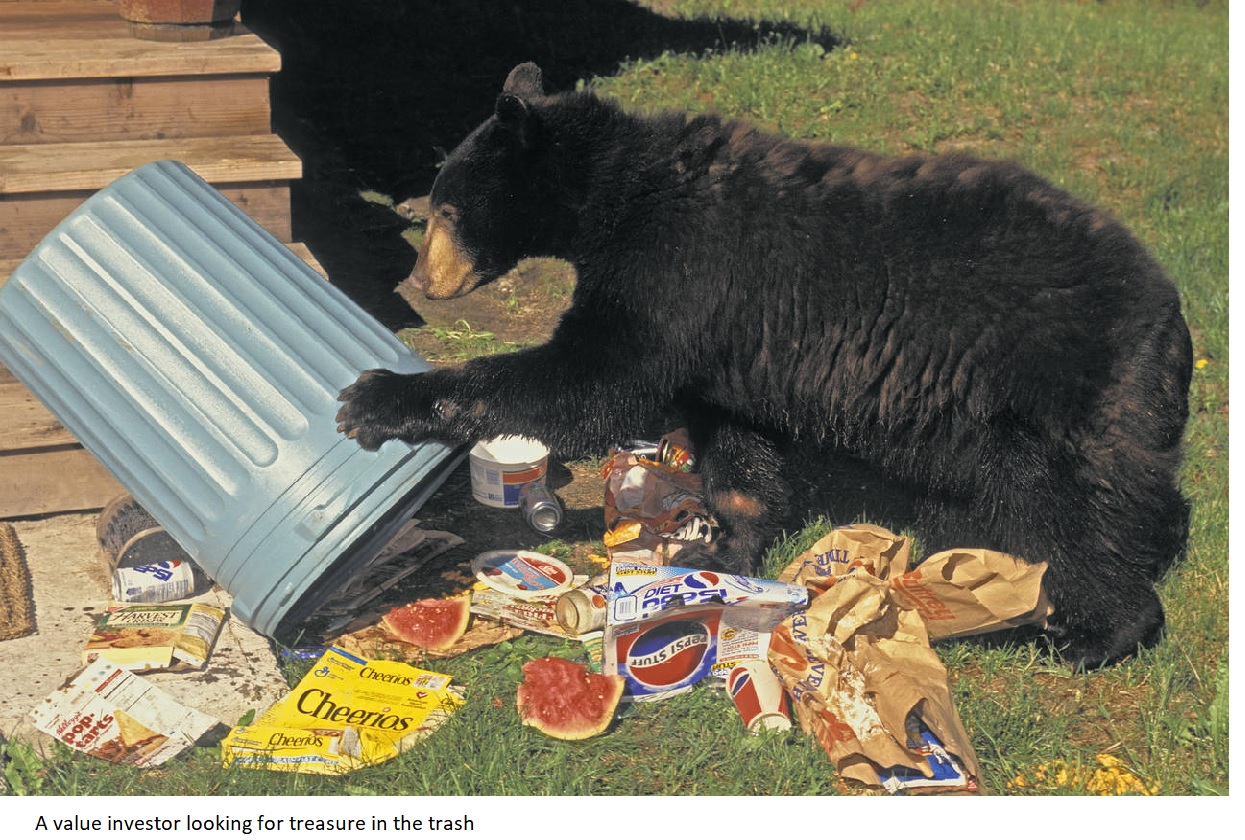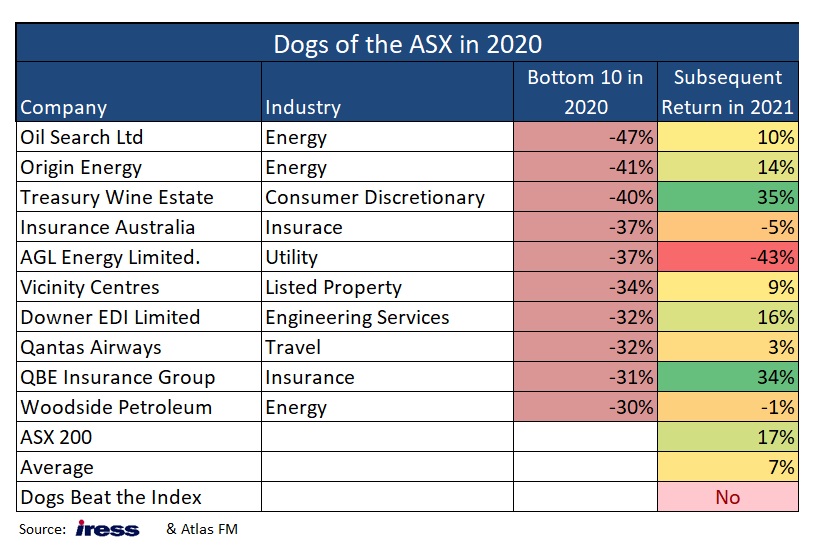Dogs of the ASX in 2021
The last 12 months have been very kind to equity investors, with the ASX trending upwards throughout the year. The ASX finished +17% ahead of where it ended 2020 and all its sectors posted a positive gain except for tech stocks. More importantly for the psyches of bruised investors, there were no significant corrections throughout the year; this despite falling iron ore prices throughout the year, new lockdowns in Eastern Australia, and the emergence of the Omicron variant late in 2021. Indeed, the August reporting season saw a record $40 billion in dividends declared by Australian companies, beating the previous record of $28 billion set in August 2019. After periods of good fortune, which saw the share prices of many companies surge ahead of valuations, it is natural to look at those companies with share prices marked down. Several companies are inevitably out of favour every January but will see their share prices rebound strongly by December.
In this first weekly piece of 2022, we will look at the "dogs" of the ASX in 2021, see how 2020 Dogs performed, consider some predictions for 2022, and review of Atlas' forecasts from January 2021 (see Dogs of the ASX 2020)

Dogs of the Dow
Michael O'Higgins popularised a systematic strategy of investing in underperforming companies named "Dogs of the Dow" in his 1991 book "Beating the Dow." This approach draws on the same investment principles as deep value and contrarian investors. O'Higgins advocated buying the ten worst-performing stocks over the past 12 months from the Dow Jones Industrial Average (DJIA) at the beginning of the year, but restricting the stocks selected to those that are still paying a dividend. Restricting the investment universe to a large capitalisation index like the DJIA or ASX 100 improves the chance that the unloved company may have the financial strength or understanding capital providers (such as existing shareholders and banks) that can provide additional capital to allow the company to recover over time. The thought process behind requiring a company to pay a dividend is that its business model is unlikely to be permanently broken if it is still paying a distribution. A company's directors are unlikely to authorise a dividend if insolvency is imminent. The strategy then holds these ten stocks over the calendar year and sells them at the end of December. The process then restarts, buying the ten worst performers from the year that has just finished.
Over the past 10 years, the ASX 100 Dogs have outperformed 6 of the past 10 years. A streak that looks less impressive due to the Dogs of 2020 and 2021 underperforming.
Why this strategy works
One of the reasons this strategy persists is that institutional fund managers often report their portfolios' contents to asset consultants as part of their annual reviews. This process incentivises fund managers to sell the "dogs" in their portfolio towards the end of the year as part of "window dressing" their portfolio before being evaluated.
For example, in early 2021 fund managers with Treasury Wine in their portfolios would have faced some stern questioning from asset consultants about why they owned the troubled winemaker. Treasury was expected to face an unpleasant couple of years due to a 220% tariff that China was now applying to imported Penfolds Grange. Treasury Wine shares returned +35% (including dividends) over 2021. The winemaker has been able both to redirect some Chinese sales to other Asian countries and also to make Penfolds branded wine in both China and California in a move to circumvent the putative tariffs imposed on Australian wine. While this strategy is yet to replace the lost higher-margin sales to China, it has improved sentiment towards the company.
Here retail investors can have an advantage over institutional investors. Their lack of scrutiny from asset consultants allows them the flexibility to pick up companies whose share prices have been under pressure late in the year that could see a rebound when the selling pressure stops in January and February. Furthermore, retail investors can afford to take a longer-term view on the investment merits of a particular company that may have hit a speed bump.
Dogs from 2020

Over the past year, the Dogs from 2020 returned +7%, underperforming the ASX 200 index's return of 17% in a year of above-average returns for the ASX. Continued underperformance from AGL Energy and IAG was too much to outweigh the gains of Treasury Wine and QBE Insurance to allow an equally weighted portfolio of the Dogs from 2020 to outperform a surging ASX in 2021.
The common theme in the reversal of performance for the two stars of the 2020 Dogs – QBE Insurance and Treasury Wine – were improvements in the company-specific issue weighing on the share price. QBE Insurance had a very solid 2021 benefiting from premium rate increases, cost reductions and sound underwriting. Furthermore, the insurer will benefit from rising interest rates.
Three energy companies appear on the list of the 2020 Dogs: Oil Search, Origin and Woodside. On average they returned only returned +8% in 2021. This return was a surprise in a year where the oil price rallied +60%, as energy companies' share prices are usually closely correlated with the price of oil. Atlas attribute this disconnect to uncertainty around major corporate acquisitions conducted in 2021 for Oil Search (merger with Santos) and Woodside (merger with BHP Petroleum), as well as oil companies being screened out by ESG algorithms. Ultimately the share prices of these companies will revert to the market price of oil and LNG.
Predictions from January 2020
When we went through this exercise in January 2021, looking at which of the Dogs of 2020 would shine in 2021, Atlas saw that the pain would continue for Qantas and Treasury Wine. This was due to these companies’ inability to reverse the issue that caused their share price decline in 2020, namely travel restrictions and Chinese tariffs. Here we were correct with Qantas but wrong on Treasury Wine as we dismissed the strategy of making Californian Penfolds and using Chinese grapes to rebuild sales in China. While these moves are yet to replace the approximately $600 million in sales previously made in China, it has excited certain investors.
In the case of QBE Insurance and IAG, we underestimated the extent of rising premiums and increasing interest rates while we expected increases in premiums. Fortunately, Atlas owns QBE Insurance in the portfolio which outperformed IAG by +39% due to IAG's higher claims and some self-inflicted wounds around not changing clauses in their business interruption insurance.
In January 2021 Atlas predicted that oil would recover in 2021, precipitating a strong recovery in the energy companies that appeared on the list of the Dogs from 2020. This prediction proved correct, with oil recovering from an average of US$42/barrel in 2020 to US$70/barrel throughout 2021. Atlas' forecasts that the energy stocks would rebound in 2021 and that Woodside would outperform were less accurate. While this is disappointing, we are unwilling to admit defeat, with Woodside expected to report 2021 net profits in February 2022 in the region of US$1.1 billion – a significant increase over 2020 net profits of US$447 million. As discussed above, Atlas believes that the lack of positive momentum on Woodside's share price in 2021 has less to do with rising earnings and dividends and more to do with concerns around the merger with BHP Petroleum. The merger will see BHP shareholders issued with Woodside shares and will turn Woodside into one of the largest global energy companies.
Overall our predictions from January 2021 were worse than those in previous years.

Unloved Mutts from 2021 in Need of a Good Home in 2022
Historically, finding the fallen angel amongst the worst performers seems to work best where the underperformance is due to stock-specific problems rather than macroeconomic issues beyond a company's control. Macroeconomic issues beyond a company's control include AGL facing falling wholesale electricity prices, or A2 Milk facing regulatory issues in China and falling e-commerce sales. Additionally, where the underperformance is due to a company-specific problem, the company in question may receive a takeover offer from a suitor who believes they can snap up the company cheaply and then fix its issues.
Unlike previous years, the list of the bottom ten performing stocks in the ASX 100 is not concentrated in a few sectors. Rather, this year’s list is populated by companies whose woes were linked to company-specific issues, typically indicating rich pickings for the coming year. Looking at the two financial companies on the above list, it is hard to pick Magellan as a candidate for a bounce-back, as the company's issues in late 2021 are likely to intensify in 2022. AMP has been a serial inclusion since 2018 on the annual Dogs of the ASX 100, with its share price falling from $5 to $1. AMP could, however, see a takeover offer in 2022, though potential suitors have walked away in the past.
After agreeing to a takeover in mid-2021, AfterPay's share price is tethered to Block's (née Square) share price in the NYSE. As we have no unique insight into Square's global merchant payments activities and are alarmed at its price-earnings ratio of 156x, it is tough to pick AfterPay as the sharp recovery candidate in 2022.
For 2022 we are picking Orica and Lend Lease as the candidates for a strong rebound in 2022. Orica's fall in 2021 was attributed to decreasing thermal coal volumes which resulted in reduced demand for explosives. However, in 2022 the outlook for coal looks robust, particularly in light of major exporter Indonesia banning coal exports in January 2022. This move by the Indonesian government is being made to divert coal to domestic power producers and will be beneficial for Australian coal miners and hence Orica. Lend Lease looks like an attractive takeover candidate in 2022, with an attractive $110bn global development pipeline, and because it currently trades on a cheap multiple. Additionally, Lend Lease is a more palatable and cleaner acquisition target since exiting its volatile engineering business.
Never miss an insight
Enjoy this wire? Hit the ‘like’ button to let us know. Stay up to date with my content by hitting the ‘follow’ button below and you’ll be notified every time I post a wire.
Not already a Livewire member? Sign up today to get free access to investment ideas and strategies from Australia’s leading investors.
5 stocks mentioned

